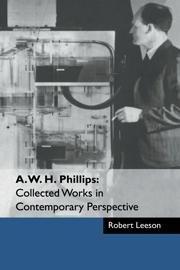Book contents
- Frontmatter
- Contents
- List of contributors
- Foreword by Arthur Brown
- Preface by Robert Leeson
- Part I Bill Phillips: Some Memories and Reflections
- Part II The Phillips Machine
- 8 The origins of the machine in a personal context
- 9 The Phillips Machine as a ‘progressive’ model
- 10 Mechanical models in economic dynamics
- 11 The history of the Phillips Machine
- 12 Early reactions to Mark I and II
- 13 A superb explanatory device
- 14 The Phillips Machine and the history of computing
- Part III Dynamic Stabilisation
- Part IV Econometrics
- References
- Index of names
- Index of subjects
10 - Mechanical models in economic dynamics
Published online by Cambridge University Press: 04 May 2010
- Frontmatter
- Contents
- List of contributors
- Foreword by Arthur Brown
- Preface by Robert Leeson
- Part I Bill Phillips: Some Memories and Reflections
- Part II The Phillips Machine
- 8 The origins of the machine in a personal context
- 9 The Phillips Machine as a ‘progressive’ model
- 10 Mechanical models in economic dynamics
- 11 The history of the Phillips Machine
- 12 Early reactions to Mark I and II
- 13 A superb explanatory device
- 14 The Phillips Machine and the history of computing
- Part III Dynamic Stabilisation
- Part IV Econometrics
- References
- Index of names
- Index of subjects
Summary
There has been an increasing use in economic theory of mathematical models, usually in the form of difference equations, sometimes of differential equations, for investigating the implications of systems of hypotheses. However, those students of economics who, like the present writer, are not expert mathematicians, often find some difficulty in handling these models effectively. This article describes an attempt to develop some mechanical models which may help non-mathematicians by enabling them to see the quantitative changes that occur in an interrelated system of variables following initial changes in one or more of them. One model has been made for the University of Leeds, a second and improved version is now being made for the London School of Economics.
Fundamentally, the problem is to design and build a machine the operations of which can be described by a particular system of equations which it may be found useful to set up as the hypotheses of a mathematical model, in other words, a calculating machine for solving differential equations. Since, however, the machines are intended for exposition rather than accurate calculation, a second requirement is that the whole of the operations should be clearly visible and comprehensible to an onlooker. For this reason hydraulic methods have been used in preference to electronic ones which may have given greater accuracy and flexibility, the machines being made of transparent plastic (‘Perspex’) tanks and tubes, through which is pumped coloured water.
- Type
- Chapter
- Information
- Publisher: Cambridge University PressPrint publication year: 2000
- 3
- Cited by



